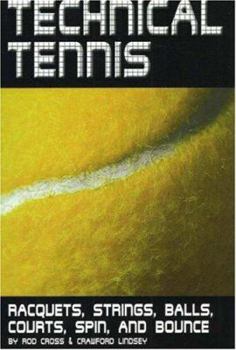Technical Tennis: Racquets, Strings, Balls, Courts, Spin, and Bounce
Select Format
Select Condition 
Book Overview
"What are the single most important variables in racquet performance? What racquet and string features combine to provide the most control, comfort, and feel? How can a player create maximum spin?... This description may be from another edition of this product.
Format:Paperback
Language:English
ISBN:0972275932
ISBN13:9780972275934
Release Date:September 2005
Publisher:Racquet Tech Publishing
Length:152 Pages
Weight:0.83 lbs.
Dimensions:0.5" x 5.9" x 8.9"
Customer Reviews
5 ratings
Truly technical
Published by Thriftbooks.com User , 17 years ago
Technical to a fault, but exacting. Provides interesting, sometimes counter-intuitive information, e.g., on how the tennis ball bounces, and how racquets really perform.
Good to know
Published by Thriftbooks.com User , 17 years ago
For the serious tennis player or anyone trying to learn more about tennis it's great.
An excellent update to "The Physics and Technology of Tennis"
Published by Thriftbooks.com User , 17 years ago
A few years back I did read "The Physics and Technology of Tennis." Even though this was a sensational book that gave me the physics knowledge to moonlight as a racquet development consultant, "Technical Tennis" is a great update. "The Physics and ..." consists of a collection of papers that were published in TennisPro magazine between 1993 and 2000. Meanwhile, "Technical Tennis" was published in 2005. Tennis technique and technology have changed since the mid nineties. The authors thoroughly study these changes. They do a great analysis of Sampras second serve that remained a standard even for today's pros. They also analyze Federer's forehand that is a marvel of versatility, speed, and accuracy. Nobody hits a forehand using Federer's technique. But, maybe thanks to this book more tennis players and especially pros will emulate it. The authors' opinions have become more complex and nuanced over time. In "The Physics ..." they stated unequivocally that heavier racquets gave you more power, control, and felt better all around than lighter ones. Now, they indicate it depends somewhat on your playing style. And, they come up with an all around "ideal" weight of 342 grams or 12 ounces. That is heavier than most recreational racquets sold in store. But, it is not heavy vs what the pros use. On page 55, they also indicate that to reduce the force on your arm there are five things you can do: 1) Use a heavier racquet; 2) Use a head heavy racquet; 3) Use a more flexible racquet (not a widebody one); 4) Lower the string tension; 5) Use a softer thicker grip. These are different recommendations than in "The Physics ..." book. Back then they recommended a stiff racquet. The authors also study in greater details the relationship between racquet weight and ball speed. And, how the relationship is different for serves vs groundstrokes. If you read "The Physics ..." book, you have to read this one to update your knowledge. If you have not, you don't need to read it, and can jump in straight into this one. It will provide you with all the physics you care about. This book is really not dummed down much. Be ready for that. At times the physics discourse gets pretty dry and challenging. But if you digest it, it's pretty interesting stuff.
Read this book before you buy a racket or take a lesson.
Published by Thriftbooks.com User , 18 years ago
This book cuts through all the marketing hype and gets to the physics of rackets, balls, and courts. Explains what matters when selecting a racket. Helped me find a racket that helps my tennis elbow. The previous book was very long. It also was redundant and contradictory in places. This book solves those problems. Of particular interest is the section on how to deliver spin. Two things were very interesting: 1) most modern forehands get their topspin not by swinging dramatically upward, but by swinging fairly falt but closing the racket face. 2) There are no topspin serves, only slices. Also, the swing is dramatically outward from 8 to 2 oclock. this greatly simplifes the overly complex instruction that is commonly proferred. GREAT book.
Technical but accessible
Published by Thriftbooks.com User , 18 years ago
The previous "version" of this book -- The Physics and Technology of Tennis -- is a daunting read for all but a few. In Technical Tennis, the authors cover many of the most important technical aspects relating to the interactions among racquets, strings, balls, and court surfaces, but the information is MUCH more accessible (and portable). The writing style is smoother, too, than Physics, so one could actually read through this entire volume in an evening. This book represents a great effort to render a complex subject in such a way that the concepts and principles are within the grasp of the interested lay-person, without being condescending or patronizing.




